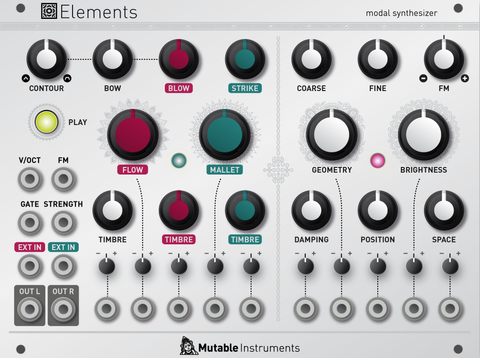Mutable Instruments Elements
$0.00
Mutable Instruments Elements
Modal synthesizer
Overview
Elements is a full-blown synthesis voice based on modal synthesis – an under-appreciated flavour of physical modelling synthesis with a strange and abstract feel.
Elements combines an exciter synthesis section, generating raw, noisy sounds characteristic of bowing (filtered friction noise), blowing (pitch-controlled granular noise), or striking (stick, mallet, hammer or brush sample playback… or bursts of synthetic impulsions). These sources, or external audio signals, are processed by a modal filter bank – an ensemble of 64 tuned band-pass filters simulating the response of various resonant structures (plates, strings, tubes…) with adjustable brightness and dampening. A stereo ambience reverberator adds depth and presence to the sound.
All parameters have a very meaningful and well-delimited impact on the sound. When designing Elements, a great care has been taken in selecting parameter ranges and control curves producing a large palette of sounds – often beyond physical realism – but always well controlled and stable. The “dark spots” of noise and feedback are reached gradually, and they do still react to controls. The module is deliberately menu- and switch-free – what you dial/patch is what you hear!
Modal synthesis voice comprising a noisy and impulsive excitation signal generator, and a 64-partial modal resonator.
Excitation signal generator
-
Three generators with mixer: bowing noise, blowing noise, percussive impulses.
-
Envelope contour for bowing and blowing.
-
Bowing noise generator: particle-like scratching noise with 2-pole low-pass filter.
-
Blowing noise generator: granular pitched noise with wavetable-like scanning between various tone colors.
-
Percussive impulse generator: interpolates through a collection of impulsive excitations – including sampled sticks, brushes and hammers, and models of damped mallets, plectrums, or bouncy particles. 2-pole low-pass filter and pitch control.
Modal resonator
-
Internally uses 64 zero-delay state variable filters.
-
Coarse, fine and FM frequency controls.
-
Geometry: Interpolates through a collection of structures, including plates, strings, tubes, bowls.
-
Brightness. Specifies the character of the material the resonating structure is made of – from wood to glass, from nylon to steel.
-
Damping. Adds damping to the sound – simulates a “wet” material or the muting of the vibrations.
-
Position. Specifies at which point the structure is excited.
-
Space. Creates an increasingly rich stereo output by capturing the sound at two different points of the structure, and then adds more space through algorithmic reverberation.
Inputs & Outputs
-
All exciter and resonator parameters have a dedicated CV input with attenuverter.
-
1V/Oct input for controlling main resonator frequency.
-
FM input.
-
Gate input.
-
Strength input, for amplitude control of the exciter section.
-
Pre- and post- exciter envelope external audio inputs.
-
Stereo audio output, with adjustable width/reverberation. It is also possible to output the raw exciter signal on one channel, and the raw resonator signal on the other.
Technical characteristics
-
Input impedances: 100k.
-
CV range: +/- 8V. CVs outside of this range are simply clipped.
-
Audio acquisition and restitution: 16-bit, 32kHz (Kindly note that Elements’ synthesis method is inherently band-limited; and that the module synthesizes “full-bodied” sounds – the choice of 32kHz is deliberate and should not be seen as a limitation).
-
Internal computations on 32-bit floating point numbers.
-
Open-source hardware and firmware.
-
Easy firmware updates through an audio interface.
-
Cortex-M4 ARM processor.
-
34-HP.
-
Current consumption: +12V: 130mA ; -12V: 10mA.
Manufacturer
N/A
Format
N/A
Functions
N/A
Bus Board Cable Type
N/A
Width
N/A
Power Supply
N/A
Depth
N/A
Max Current
N/A
CV IO
N/A


